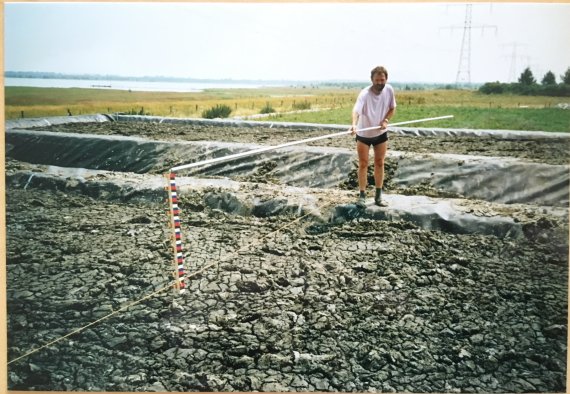Joop Harmsen takes a depth measurement during the ripening of dredging in 1994. © Joop Harmsen
PAHs commonly occur in water beds. These layers are released as dredging during watercourse maintenances. Contaminated dredging from Dutch waterways is currently stored in depots in low-oxygen conditions. In retrospect, that was not the best solution. ‘That way, the dredge spoil remains contaminated’, says Joop Harmsen (Sustainable Soil Use). Harmsen and Rietra’s research shows that the slow availability of the PAHs for degradation by micro-organisms and the creation of oxygen-rich conditions are the key factors for the biodegradation of PAHs. According to Harmsen, these circumstances can be facilitated. ‘In the presence of vegetation, high amounts of oxygen enter the soil, which in turn means that the PAHs are decomposed faster.’
What are PAHs?
- ‘Polycyclic Aromatic Hydrocarbons, or PAHs, arise in incomplete combustion processes’, Harmsen says. ‘It is a classic form of pollution that occurs everywhere. Sources include coal-based gas plants, fuel used for heating, cigarette smoke and burnt meat on the barbecue. All PAHs are toxic, but some of them are carcinogenic, which is why they are seen as a contamination we must take care of.’
New policies
In 1994, Harmsen began with his research into the biodegradation of PAHs in contaminated dredging. The dredging was transported to a ‘land farm’ where it could be dehydrated and exposed to oxygen. It was initially expected that the PAHs would be decomposed in two years’ time, but the slow biodegradation process eventually had to be monitored for twenty-five years. As it turned out, the part of the PAHs immediately available for microorganisms in the contaminated dredging was biodegraded within one year. Another part of the PAHs, which was released more slowly, was decomposed in seven years’ time. Finally, a residual part of the PAHs is released very slowly and is degraded in the following twenty years.

If you have a contaminated location: manage it in such a way that oxygen can reach it.
Joop Harmsen, Sustainable Soil Use researcher
What do these outcomes mean for policy? ‘You now know that contaminated dredging will eventually be clean. You could consider that in zoning plans’, says Harmsen. ‘And if you have a contaminated location: manage it in such a way that oxygen can reach it.’

